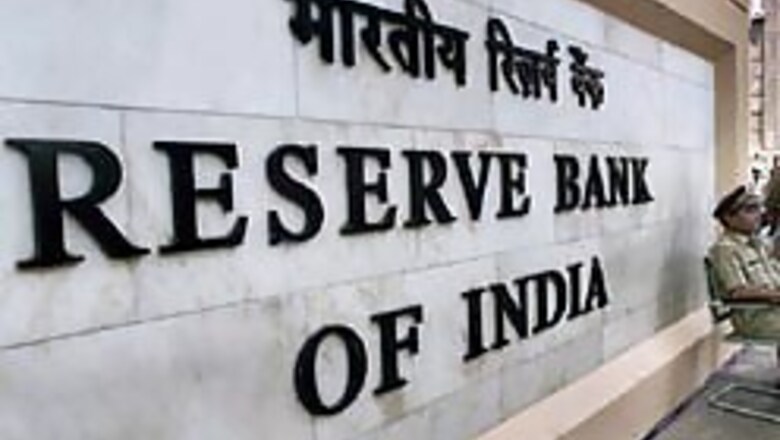
views
New Delhi: The RBI has left repo rates and reverse repo rates unchanged in its credit policy. But keeping inflation in mind, it has hiked CRR by 25 basis points to 8.25%. It’s the second hike in 2 weeks. That move will drag more liquidity out of the system.
The RBI said it is attempting to bring down inflation to 5.5 per cent in the next fiscal with a long-term target of 4-4.5 per cent.
The RBI has estimated the GDP growth next year will be 8 per cent to 8.5 per cent.
India's biggest home loan lender ICICI Bank has said that it will wait and watch before taking any steps.
ICICI Bank MD & CEO said, “CRR hike will mean that liquidity will come down marginally. We will take a call on it after analysing demand supply and liquidity conditions.”
Today's increase would suck out over Rs 9,000 crore excess funds from the banking system, while the 0.5 per cent increase in CRR announced on April 17 was aimed at squeezing out Rs 18,500 crore from the system.
The move is aimed at fighting inflation, which is ruling at an intolerable 7.33 per cent. The high rate has prompted RBI to revise its inflation comfort band from the earlier 5 per cent to 5.5 per cent.
"Inflationary pressures from international food and energy prices appear to have amplified and by current indications, are likely to remain so for some time," it added. The apex bank said it looks to reduce inflation to 3 per cent in the medium term.
Although measures to tackle inflation are widely expected to trip economic expansion, the RBI projected India's GDP to grow by a healthy 8-8.5 per cent for 2008-09 assuming that global financial and commodity markets and real economy will be broadly aligned with the central scenario and normal monsoon conditions prevail.
"There are concerns that demand pressures, which have been reasonably contained so far are being coupled with supply-side factors, which if not temporary, could impact domestic inflation significantly," the RBI said.
Recognising the evolving constellation of adverse international developments, the RBI said it will respond swiftly with "both conventional and unconventional measures" against factors impinging on inflation expectations, financial stability and growth momentum.
Next page: Highlights of RBI credit policy
PAGE_BREAK
Highlights of RBI credit policy for 2008-09
Following are the highlights of the annual policy statement of RBI for 2008-09 announced by its Governor Y V Reddy
- CRR rate increased by 0.25 per cent to 8.25 per cent
- Bank Rate (6 per cent), Repo Rate (7.75 per cen) Reverse
- Repo Rate (6 per cent) unchanged.
- GDP growth projected at eight to 8.5 per cent for 2008-09
- Inflation to be pegged to 5.5 per cent with preference for bringing it close to five per cent as soon as possible to condition policy and perceptions for inflation in the range of four to 4.5 per cent so that inflation rate of around three per cent.
- M3 expansion to be moderated in the range of 16.5 to 17 per cent becomes a medium term objective.
- High priority to price stability, well anchored inflation expectations and orderly conditions in financial markets while sustaining the growth momentum.
- Deposits projected to increase by around 17 per cent or Rs 550,000 crore.
- Adjusted non-food credit projected to increase around 20 per cent.
- A clearing and settlement arrangement for over the counter rupee derivatives proposed.
- Domestic crude oil refining companies would be permitted to hedge commodity price risk on overseas exchanges/markets on domestic purchase of crude oil and sale of petroleum products based on underlying contract.
- Currency futures to be introduced in eligible exchanges in consultation with the SEBI, broad framework to be finalised by May 2008.
- Indian companies to be allowed to invest overseas in energy and natural resources sectors.
- RBI can be approached for capitalisation of export proceeds beyond the prescribed period of realisation.
- Loans granted to RRBs for on lending to agriculture and allied activities to be classified as indirect finance to agriculture.
- The shortfall in lending to weaker sections would be taken into account for contribution to Rural Infrastructure Development Fund from April 2009.
- RRBs allowed to sell loan assets to other banks in excess of their prescribed priority sector exposure.
- RBI to disseminate details of various charges levied by banks.
- Asset classification norms for credit to infrastructure projects relaxed.
- The prudential guidelines for specific off balance sheet exposures of banks to be reviewed.
- RBI to carry out supervisory review of banks' exposure to commodity sector.
- The limit of bank loans to individuals for housing having lower risk weight of 50 per cent enhanced from Rs 20 lakh to Rs 30 lakh.
- Consolidated supervision of financial conglomerates proposed.
- Working group to be set up for a supervisory framework for SPVs/Trusts.
- Inter departmental group to review the existing regulatory and supervisory framework for overseas operations of Indian banks.
- All transactions of Rs one crore and above made mandatory to be routed through the electronic payment mechanism.
- Dispense with the extant eligibility norms for opening on-site ATMs for well managed and financially sound Urban Cooperative Banks.
- Regulations in respect of capital adequacy, liquidity and disclosure norms for systemically important NBFCs to be reviewed.




















Comments
0 comment